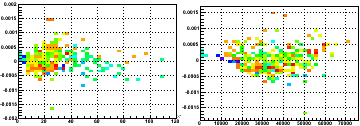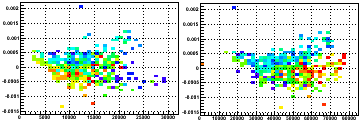- General information
- Data readiness
- Calibration
- BeamLine Constraint
- Calibration Run preparation
- Calibration Schedules
- Calibration topics by dataset
- Docs
- STAR Automated Calibration Project
- SVT Calibrations
- TPC Calibrations
- Drift velocity
- Enter TPC gains into database
- Field Cage Shorts
- Miscellaneous TPC calibration notes
- Padrow 13 and Padrow 40 static distortions
- RunXI dE/dx calibration recipe
- SpaceCharge and GridLeak
- SpaceCharge and GridLeak Calibration How-To Guide
- Effect of SVT and SSD on SpaceCharge Calibration
- SpaceCharge azimuthal anisotropy
- AuAu15 (2014)
- AuAu19 (2011)
- AuAu200 (2004)
- AuAu200 (2007)
- AuAu200 (2011)
- AuAu200 (2014)
- AuAu200 (2016)
- AuAu27 (2011)
- CuAu200 (2012)
- CuCu200 (2005)
- CuCu22 (2005)
- GridLeak R&D
- UU193 (2012)
- dAu20 (2016)
- dAu200 (2008)
- dAu200 (2016)
- dAu39 (2016)
- dAu62 (2016)
- pAl200 (2015)
- pAu200 (2015)
- pp200 (2006)
- pp200 (2009)
- pp200 (2015)
- pp400 (2005)
- pp500 (2011)
- pp510 (2012)
- pp510 (2013)
- pp62 (2006)
- TPC Hit Errors
- TPC OmegaTau
- TPC Sector Alignment
- TPC Slewing
- TPC T0s
- TPC de/dx
- TPC survey instructions
- Twist (ExB) Distortion
- Databases
- Quality Assurance
- Calibration
- Grid and Cloud
- Infrastructure
- Machine Learning
- Offline Software
- Production
- S&C internal group meetings
- Test tree
dAu200 (2008)
Updated on Tue, 2009-01-20 10:58. Originally created by genevb on 2008-08-12 18:20.
Under:
Some studies were done initially to get a good guess at the SpaceCharge in dAu.
There were some concerns from the You do not have access to view this node regarding offsets in the measurement of the GridLeak distortion, which we tried to use You do not have access to view this node to correct (albeit unsuccessfully). This was eventually You do not have access to view this node.
Results of the original calibration:

Processing Calib_SC_GL.C("inputs/input1.dat","dca>-5",2)...
Found 6 dataset specifications.
64 files added from hists/hists3.0_9.0/Hist*
65 files added from hists/hists2.5_7.0/Hist*
64 files added from hists/hists2.82_8.5/Hist*
1 files added from hists/HIST2.6_8.6*
65 files added from hists/hists2.0_10.0/Hist*
63 files added from hists/hists2.6_8.8/Hist*
* Constraint on SC x GL = 2.27e-06 +/- 9.71e-08
* Guesses on SC = 2.57e-07 , 2.6e-07 , 1.54e-07 , -2e-07
* Guesses on GL = 8.82 , 14.7 , 8.74 , -11.3
* Guesses on SO = 438 , 436
*** FINAL CALIBRATION VALUES: ***
SC = 2.6e-07 * ((zdcx) - ( 437)) with GL = 8.74
A test production was run in July, and the QA of that data showed You do not have access to view this node. The good news was that the backgrounds appeared to be not localized to any one part of the TPC (signed DCAs were consistently off at all phi for high background data), and remaining gap distortions appeared to be roughly linearly proportional to remaining DCAs.
The calibration was modified to use a principal components analysis using the TPrincipal class. In the process, two bugs (one and two) were found in the TPrincipal class and are only corrected in ROOT versions 5.21 and later. The analysis was tested using the same input as for the original calibration and came up with similar results, so it was deemed viable:
SC = 2.53e-07 * ((zdcx) - ( 266))
The analysis used eight scalers ("zdcx:zdcw:zdce:bbcx:bbcw:bbce:bbcbb:bbcyb") to determine what combinations provided the least variance in measured SpaceCharge (which equals SpaceCharge used to correct the data plus SpaceCharge converted from remaining observed signed DCAs). As in the original calibration, zdcx was the clear choice among those for using only one scaler. It was also found that combinations of zdcx and bbcbb did best among the two scaler options, and not much further improvement resulted from using three or more scalers.
However, no options were found which did a good job of satisfying the entire dAu dataset when using the full test production sample. Early and late runs appeared to require different calibrations, as can be seen in this plot of measured SpaceCharge vs. BBC blue background, where blue/red points are from runs before/after 9004000 respectively when using the best calibration from the full dataset.

So separate calibrations were done for runs prior to and after 9004000. Again, the two scaler calibration using zdcx and bbcbb appeared to be just about as good as anything with more scalers. One other note is that the StSpaceChargeEbyEMaker code had an upper limit in its histograms for SpaceCharge of 0.025, which resulted in getting erroneous fits to the measured amount of SpaceCharge at the very highest luminosities, and I had to cut out anything with a measured SpaceCharge above 0.020. So the Here are the results:
SC = (2.57852e-07*(zdcx-1490.565143))+(3.14451e-08*bbcbb) {run < 9004000}
SC = (2.21883e-07*(zdcx-3886.606142))+(1.58750e-07*bbcbb) {run > 9004000}
Here then is the remaining measured SpaceCharge versus bbcbb and zdcx (left and right within pair) for the pre and post 9004000 dAu runs (upper and lower pairs) where the color represents days (blue is earliest days, red is latest days):


The pre 9004000 runs show that nearly all dependencies are removed. Also, this calibration moves the low luminosity fill away from zero, so the original calibration above will be kept for the low luminosity fill because that does zero the data.
For the post 9004000 runs data, there still seems to be some dependency which I have not gotten rid of in this analysis (I have tried using more scalers and it does not help). There appears to be potential for dividing the data into two further subsets in time, and I'm still exploring that possibility. But the level of calibration looks pretty good already.
»
- Printer-friendly version
- Login or register to post comments
